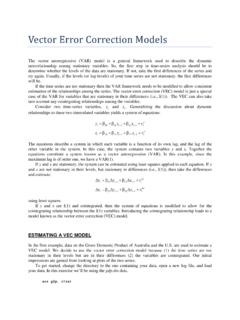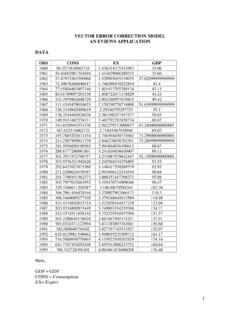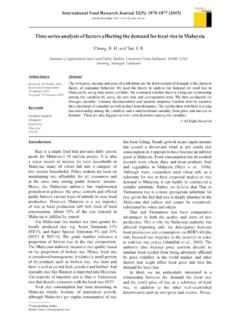Transcription of DF-GLS vs. Augmented Dickey-Fuller
1 DF-GLS vs. Augmented Dickey-Fuller This is almost completely taken from the Stata 11 Manual Time-Series. dfgls tests for a unit root in a time series. It performs the modified dickey fuller t test (known as the DF-GLS test) proposed by Elliott, Rothenberg, and Stock (1996). Essentially, the test is an Augmented dickey fuller test, similar to the test performed by Stata s dfuller command, except that the time series is transformed via a generalized least squares (GLS) regression before performing the test. Elliott, Rothenberg, and Stock and later studies have shown that this test has significantly greater power than the previous versions of the Augmented dickey fuller test. dfgls performs the DF-GLS test for the series of models that include 1 to k lags of the first differenced, detrended variable, where k can be set by the user or by the method described in Schwert (1989). Stock and Watson (Introduction to Econometrics, 2nd ed.)
2 2007, 650 655) provide an excellent discussion of the approach. As discussed in [TS] dfuller, the Augmented dickey fuller test involves fitting a regression of the form t yyu = + + + + + + and then testing the null hypothesis H0: 0. =The DF-GLS test is performed analogously but on GLS-detrended data. The null hypothesis of the test is that yt is a random walk, possibly with drift. There are two possible alternative hypotheses: tyis stationary about a linear time trend or ty is stationary with a possibly nonzero mean but with no linear time trend. The default is to use the former. To specify the latter alternative, use the notrend option. References Cheung, , and K. S. Lai. 1995. Lag order and critical values of a modified dickey fuller test. Oxford Bulletin of Economics and Statistics 57: 411 419. Elliott, G., T. J. Rothenberg, and J. H. Stock. 1996. Efficient tests for an autoregressive unit root .
3 Econometrica 64: 813 836. Ng, S., and P. Perron. 1995. unit root tests in ARMA models with data-dependent methods for the selection of the truncation lag. Journal of the American Statistical Association 90: 268 281. -- . 2000. Lag length selection and the construction of unit root tests with good size and power. Econometrica 69: 1519 1554. Schwert, G. W. 1989. Tests for unit roots: A Monte Carlo investigation. Journal of Business and Economic Statistics 2: 147 159. ers present interpolated critical values from Elliot, Rothenberg, and Stock notrend series is stationary around a mean instead of around a linear time trend maxlag(#) use # as the highest lag order for Dickey-Fuller GLS regressions Main options description dfgls varname [if] [in] [, options]Syntax [TS] dfgls DF-GLS unit - root testTitle Example German macroeconomic dataset and test whether the natural log of income exhibits a unit root .
4 Here is the time series plot, which clearly exhibits a trend: Try the Augmented Dickey-Fuller test. Include a trend. The results from dfuller also support rejecting the null hypothesis, though the p-value with four lags is close to The problem with the ADF test is low power against the stationary alternative (especially when you include a trend). So, we try the dfgls test. Remember that the dfgls includes a trend by default. investment1960q11965q11970q11975q11980q1 1985q1quarterMacKinnon approximate p-value for Z(t) = Z(t) Statistic Value Value Value Test 1% Critical 5% Critical 10% Critical Interpolated Dickey-Fuller Augmented Dickey-Fuller test for unit root Number of obs = 87.
5 Dfuller ln_inv, lag(4) trend A maximum lag of 11 is selected by the Schwert criterion. The result suggests that 7 is optimal via the Ng-Perron criterion. SC chooses 4 and MAIC only 1. This is a little confusing to me since the SC supposedly has a larger penalty. I d suggest taking a look at what the MAIC actually is. The null of a unit root is rejected at the 5% level for lags 4 8 and 11 and at the 10% level for lags 9 and 10. Min MAIC = at lag 1 with RMSE .0440319 Min SC = at lag 4 with RMSE .0398949 Opt Lag (Ng-Perron seq t) = 7 with RMSE .0388771 1 2 3 4 5 6 7 8 9 10 11 [lags] Test Statistic Value Value Value DF-GLS tau 1% Critical 5% Critical 10% Critical Maxlag = 11 chosen by Schwert criterionDF-GLS for ln_inv Number of obs = 80.
6 Dfgls ln_inv












